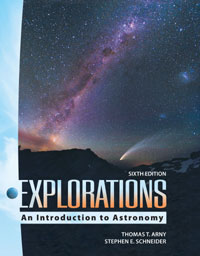 
Explorations: Introduction to Astronomy (Arny), 6th EditionChapter 7:
The Moon  <a onClick="window.open('/olcweb/cgi/pluginpop.cgi?it=jpg::::/sites/dl/free/0010202009/220722/chapter7.jpg','popWin', 'width=NaN,height=NaN,resizable,scrollbars');" href="#"><img valign="absmiddle" height="16" width="16" border="0" src="/olcweb/styles/shared/linkicons/image.gif"> (194.0K)</a> <a onClick="window.open('/olcweb/cgi/pluginpop.cgi?it=jpg::::/sites/dl/free/0010202009/220722/chapter7.jpg','popWin', 'width=NaN,height=NaN,resizable,scrollbars');" href="#"><img valign="absmiddle" height="16" width="16" border="0" src="/olcweb/styles/shared/linkicons/image.gif"> (194.0K)</a> | |
- The Solar System consists of the Sun, the nine planets, their moons, and smaller objects (such as asteroids and comets).
- The planets orbit the Sun within a flat disk-shaped region, held there by the Sun’s gravity.
- The planets form two main families:
- The four planets near the Sun (Mercury, Venus, Earth, and Mars) are rocky with iron cores and are similar to the Earth in size.
- The next four planets from the Sun (Jupiter, Saturn, Uranus, and Neptune) are much larger than the Earth and are balls of liquid or gas, rich in hydrogen and its compounds.
- Pluto fits in neither category: it is by far the smallest planet and consists of rock and ice.
- Smaller icy objects orbit beyond Pluto in the outermost regions of the Solar System.
- The Solar System formed about 4.6 billion years ago from an interstellar gas cloud that collapsed and shrank under the force of its own gravity.
- Rotation of the cloud made it flatten into a disk.
- Within the disk, gravity drew dust and gas into clumps that became the planets.
|
 |  |
|





